Intermittent fasting (IF), as defined by Sumona Mandal from University College London, refers to a dietary practice that alternates between periods of eating and fasting, commonly using time-restricted patterns like a 16-hour fasting window followed by an 8-hour eating window. Emerging evidence suggests benefits beyond weight loss, such as improved metabolic health and reduced systemic inflammation. The practice has ancient roots in various religious, cultural, and spiritual traditions, and it has gained modern popularity for its potential health benefits.
Intermittent fasting comes in several main types, each with its own set of rules and benefits. Time-restricted eating (TRE) involves a 16-hour fasting window followed by an 8-hour eating period, commonly known as the 16/8 method. Alternate Day Fasting (ADF) consists of switching between days of normal eating and days of complete fasting, while Modified Alternate Day Fasting (mADF) is a less stringent version that allows up to 40% of daily caloric intake on fasting days.
One of the primary benefits of these intermittent fasting methods is improved metabolic health, which includes better insulin sensitivity and reduced systemic inflammation. However, the main drawback is the difficulty in sticking to the diet, especially in social or family settings where communal eating is the norm.
This dietary approach is recommended for people aiming to improve metabolic health, lose weight, or simply explore a new way of eating. However, it’s not advisable for everyone, especially those with certain medical conditions or unique nutritional needs. Notable figures like Hugh Jackman, Terry Crews, LeBron James, and Jack Dorsey have publicly endorsed various forms of intermittent fasting, attesting to its growing popularity and potential benefits.
What is Intermittent Fasting?
Intermittent fasting is an eating pattern that alternates between periods of fasting and eating, often employing methods such as alternate-day fasting (ADF), the 5:2 diet, one meal a day (OMAD), or time-restricted eating (TRE). According to a 2021 study by Krista A. Varady from the University of Illinois at Chicago, these intermittent fasting methods can result in mild to moderate weight loss, ranging from 1-8% from baseline, and consistent reductions in energy intake of 10-30%. The study also highlighted that intermittent fasting is generally safe, without causing energy level disturbances or increased disordered eating behaviors.
A 2023 study by Hani Shalabi from the University of Jeddah further supported the efficacy of intermittent fasting, particularly for obese individuals aiming for weight loss, with minimal side effects like headaches, lethargy, and mood swings. Both studies indicate that intermittent fasting can be an effective and generally safe dietary strategy for weight loss and improved metabolic health.
What are the effects of Intermittent Fasting on women?
Intermittent fasting has been shown to decrease testosterone and free androgen index levels, while increasing sex hormone-binding globulin in obese premenopausal females, according to a 2022 study by Sofia Cienfuegos from the University of Illinois at Chicago. In this video, Dr. Jason Fung and special guest Megan Ramos discuss gender differences in fasting and offer three tips for women.
How does the Intermittent Fasting work?
Intermittent fasting works by restricting the time in which you can eat, leading to a decrease in overall calorie intake. This method of fasting allows your body to burn stored fat for energy, resulting in weight loss and promoting ketosis. Additionally, intermittent fasting has been shown to improve glycemic control and insulin sensitivity in individuals with type 2 diabetes. However, more long-term research is needed to fully understand the sustainable role of intermittent fasting in weight loss and overall health.
When asking about how intermittent fasting works for depression, we can reference a 2021 study by Elisa Berthelot from Aix-Marseille University. This study suggests that intermittent fasting may have potential benefits for treating depression, even though the exact mechanisms are not yet fully understood. The research indicates that intermittent fasting can improve mood and alleviate symptoms of depression, potentially due to metabolic changes such as increased ketone production and reduced inflammation.
How does Intermittent Fasting induce ketosis?
Intermittent fasting induces ketosis by restricting the availability of dietary carbohydrates, leading to a depletion of glycogen stores in the liver. Without an adequate supply of carbohydrates for energy, the body shifts to using stored fat as its primary fuel source. This metabolic adaptation promotes the production of ketone bodies, which are used by the body and brain as an alternative energy source during periods of fasting.
What are the health benefits of Intermittent Fasting?
The health benefits of intermittent fasting include improved weight loss, improved insulin sensitivity, reduced inflammation, improved cardiovascular health, increased autophagy, improved brain health, decreased oxidative stress, and extended lifespan.
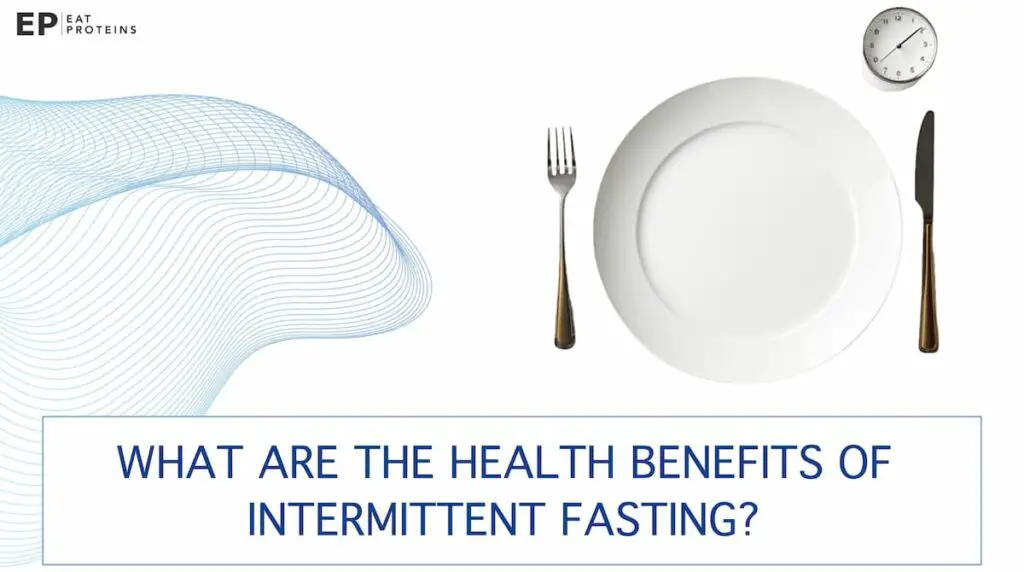
- Improved Weight Loss: According to a systematic review by Stephanie Welton and colleagues from the Northern Ontario School of Medicine, published up to July 1, 2019, intermittent fasting shows promise in treating obesity. The review, which included 41 articles describing 27 trials, found that all intermittent fasting trials resulted in weight loss ranging from 0.8% to 13.0% of baseline weight, with no serious adverse events reported.
- Enhanced insulin sensitivity: According to a 2019 study by Yongin Cho from Inha University School of Medicine, intermittent fasting diets (IFD) were found to significantly improve insulin sensitivity, glucose regulation, and other glucometabolic parameters. The study concluded that IFD led to notable decreases in body mass index (BMI), fasting glucose levels, and insulin resistance, thereby reducing the risk of type 2 diabetes.
- Reduced inflammation: As per a 2020 meta-analysis led by Xiaoli Wang from the Tongde Hospital of Zhejiang Province, intermittent fasting has been shown to significantly reduce C-reactive protein (CRP) concentrations, a key marker of inflammation. This reduction was particularly notable in overweight and obese individuals and in interventions lasting eight weeks or more. However, the study found that intermittent fasting did not significantly affect other inflammatory markers like tumor necrosis factor-α and interleukin-6.
- Improved cardiovascular health: According to a 2021 meta-analysis by Mohammed Allaf and colleagues from Imperial College London, intermittent fasting was found to be superior to ad libitum feeding in reducing weight, although the clinical significance was not substantial. The study also revealed that intermittent fasting did not show a significant clinical difference compared to continuous energy restriction in improving cardiometabolic risk factors to reduce the risk of cardiovascular disease.
- Increased autophagy: A 2023 review by Roya Shabkhizan and colleagues from Tabriz University of Medical Sciences found that intermittent fasting or calorie restriction can induce adaptive autophagy, increasing the longevity of eukaryotic cells. The study suggests that while short-term calorie restriction promotes beneficial autophagic responses, prolonged calorie restriction with excessive autophagy can be harmful and may lead to type II autophagic cell death.
- Improved brain health: In a 2023 study by Zhao Liu and colleagues from Chongqing General Hospital and Chongqing Key Laboratory of Neurodegenerative Diseases, intermittent fasting was found to have neuroprotective effects and improve long-term brain health, particularly in the context of cerebral ischemia in rats.
- Decreased oxidative stress: In a 2015 study by Martin P. Wegman and colleagues from the University of Florida College of Medicine, intermittent fasting was explored for its effects on oxidative stress and genes related to aging. The study, which involved healthy individuals following a modified intermittent fasting diet, found that intermittent fasting marginally increased the expression of SIRT3, a gene associated with aging, by 2.7% and decreased plasma insulin levels.
- Extended lifespan: In a study by Valter D. Longo and colleagues from the University of Southern California, intermittent fasting lasting from 12 to 48 hours and repeated every 1 to 7 days has the potential to prevent and treat disease while affecting cellular aging. The research also discusses how these fasting methods are linked to major nutrient-sensing signaling pathways and focuses on the benefits and side effects of fasting in relation to various diseases, including cancer, autoimmunity, and neurodegeneration.
How effective is Intermittent Fasting for weight loss?
The effectiveness of intermittent fasting for weight loss is inconclusive, with some studies showing no significant benefits and others indicating clinically meaningful weight loss. In a 2023 meta-analysis led by Giovanni Antonio Silverii from Florence University and other researchers from Careggi Hospital in Italy, which analyzed 9 randomized controlled trials involving 540 patients, found that intermittent fasting did not show a significantly greater reduction in body weight or BMI compared to control diets or continuously restricted diets.
On the contrary, in a 2022 review published in Nature Reviews Endocrinology, Krista A. Varady and colleagues from the University of Illinois at Chicago noted that intermittent fasting diets have gained significant popularity for their ability to produce clinically meaningful weight loss. The paper summarized preliminary findings on the health benefits of intermittent fasting, specifically focusing on its effects on body weight and risk factors for cardiometabolic diseases, while also assessing the safety of these diets and offering practical advice for implementation.
Is intermittent fasting effective for diabetes management?
Yes, intermittent fasting shows potential as an effective strategy for diabetes management by improving weight loss, insulin sensitivity, and metabolic markers. However, according to a 2021 study by Michael Albosta from Central Michigan University College of Medicine, more research is needed to fully understand its effects and to determine the best approach for implementing intermittent fasting in diabetes treatment.
What are the health risks associated with Intermittent Fasting?
The 6 health risks associated with Intermittent Fasting include dizziness, nausea, headache, weakness, low blood sugar, and potential exacerbation of existing medical conditions.
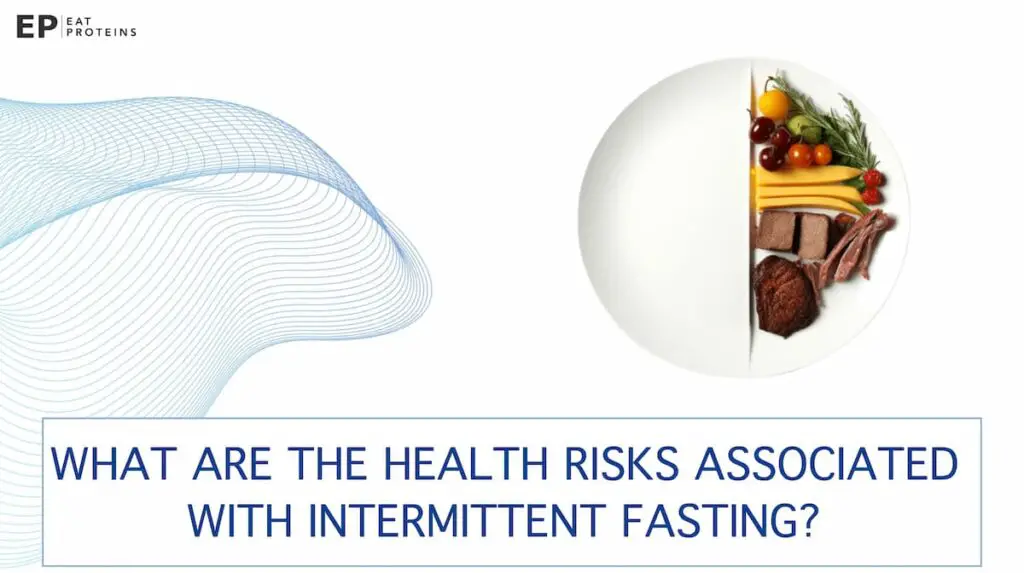
- Dizziness
- Nausea
- Headache
- Weakness
- Low blood sugar (hypoglycemia)
- Potential exacerbation of existing medical conditions.
Can Intermittent Fasting lead to weight gain?
No, intermittent fasting is typically used as a method for weight loss and can actually lead to weight loss due to reduced calorie intake. However, individual results may vary depending on other factors such as diet and exercise.
How to do Intermittent Fasting
To do Intermittent Fasting, follow the steps below.
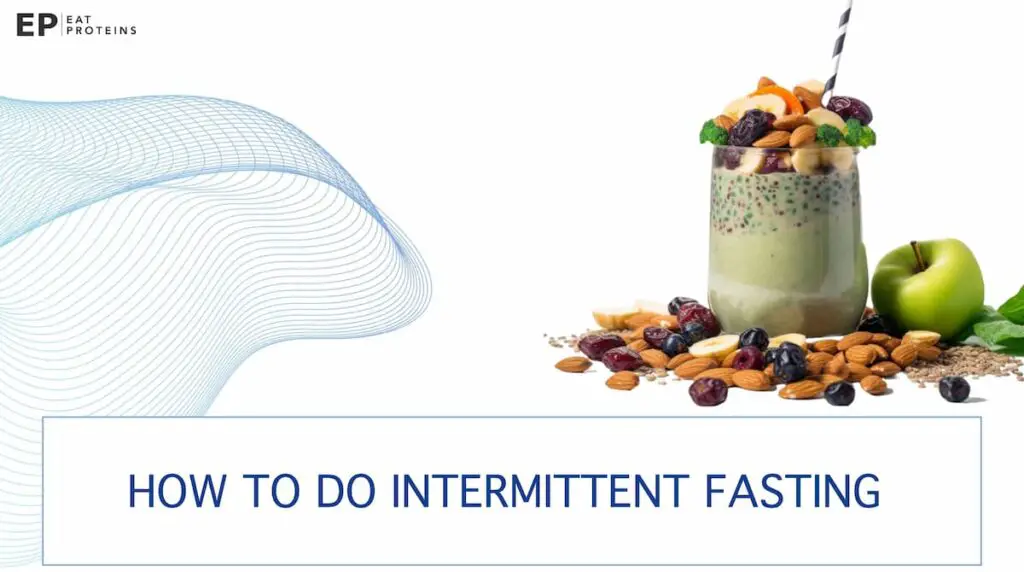
- Seek guidance from a certified nutrition coach to effectively navigate the intermittent fasting process.
- Choose an intermittent fasting schedule that is easy to follow and maintain at least 90% compliance.
- Start with small steps, such as skipping a meal or delaying one meal by an hour or two if you’re new to fasting.
- If you’re experienced with fasting, challenge yourself by picking a slightly more difficult schedule than what you’ve successfully tried before.
- Avoid the mindset of “all you can eat” during non-fasting periods and eat normally except for specific circumstances.
- Don’t overachieve in fasting as it may lead to deficiencies, hormonal imbalances, and burnout.
- Make your fasting schedule adaptable to your lifestyle, considering the level of work and preparation required for each plan.
- Stay hydrated during fasting periods and ensure you drink water regularly.
- Adjust your workouts accordingly and avoid overloading your body while following intermittent fasting.
What rules should be followed while doing intermittent fasting?
The rules to follow while doing intermittent fasting include choosing a method that works for you, maintaining consistency, staying hydrated, adjusting workouts, and setting clear goals.
- Start by choosing an intermittent fasting method that you are confident you can stick to, ensuring it aligns with your lifestyle and preferences.
- Consistency is key, so avoid changing other variables during your fasting experiment, allowing you to accurately assess the effectiveness of intermittent fasting.
- Stay hydrated by drinking plenty of water during fasting periods to support overall well-being.
- Adjust your workouts while following intermittent fasting to avoid overloading your body and maintain energy levels.
- Set clear goals for your intermittent fasting journey, whether it’s focused on fat loss, improved relationship with hunger, or other desired outcomes, and use tools like worksheets to track progress and make adjustments as needed.
What are the guidelines for women over 50 who want to try intermittent fasting?
There are no universally accepted guidelines for women over 50 who want to try intermittent fasting, but some general recommendations can be made based on existing research. A 2021 review in Experimental Gerontology suggests that both time-restricted eating and the 5:2 intermittent fasting approach can offer benefits like modest weight loss and reductions in blood pressure for middle-aged and older adults.
However, the 5:2 approach was found to produce clinically meaningful weight loss. Women over 50 who are interested in trying intermittent fasting should consult their healthcare provider for personalized advice, especially if they have preexisting medical conditions or are taking medications.
What foods are recommended to eat during Intermittent Fasting?
During intermittent fasting, it’s recommended to focus on nutrient-dense foods that are high in protein, fiber, and healthy fats to maximize satiety and nutritional intake.
Some recommended foods include the following:
- Lean proteins like chicken and fish
- Whole grains like quinoa and brown rice
- Vegetables like spinach and broccoli
- Fruits like berries and apples
- Nuts like almonds and walnuts
- Legumes like lentils and chickpeas
- Dairy or dairy alternatives like Greek yogurt and almond milk
- Healthy fats like avocado and olive oil
What foods are restricted in intermittent fasting?
During intermittent fasting, it’s typically recommended to restrict or minimize the intake of foods high in added sugars, refined carbohydrates, and processed foods. These may include sugary snacks, sugary beverages, white bread, pastries, fried foods, and high-calorie, low-nutrient foods. It’s important to focus on whole, nutritious foods during eating windows to support health and weight management.
How do you calculate your fasting and eating windows for Intermittent Fasting?
To calculate your fasting and eating windows for Intermittent Fasting, determine the total duration of fasting you aim for (e.g., 16 hours) and subtract that from the total hours in a day (usually 24 hours). This will give you your eating window duration. For example, with a 16-hour fasting goal, your eating window would be 8 hours. You can then choose the specific start and end times for your fasting and eating windows based on your daily routine and preferences.
What is the Intermittent Fasting meal plan?
The following is the 7-day Intermittent Fasting meal plan.
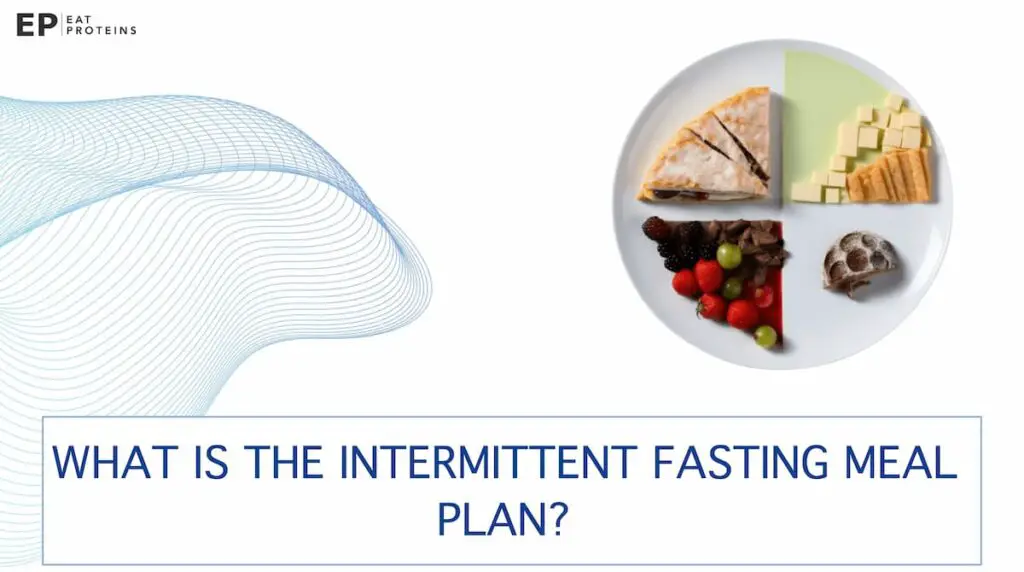
Day 1
- 2:30 pm – Grilled chicken breast with steamed broccoli
- 4:30 pm – Greek yogurt with berries
- 7:00 pm – Quinoa salad with mixed vegetables and a lemon vinaigrette
Day 2
- 2:15 pm – Baked salmon with asparagus
- 4:45 pm – Almonds and an apple
- 6:45 pm – Lentil soup with a side of mixed greens
Day 3
- 2:20 pm – Turkey and avocado lettuce wraps
- 4:00 pm – Carrot sticks with hummus
- 7:30 pm – Roasted sweet potatoes with a spinach and feta salad
Day 4
- 3:00 pm – Stir-fried tofu with mixed bell peppers
- 5:15 pm – Sliced cucumbers with tzatziki sauce
- 7:15 pm – Cauliflower rice with a chickpea curry
Day 5
- 2:45 pm – Grilled shrimp with a side of zucchini noodles
- 4:30 pm – Cottage cheese with pineapple
- 7:00 pm – Greek salad with olives, tomatoes, and feta cheese
Day 6
- 3:15 pm – Beef stir-fry with broccoli and carrots
- 5:00 pm – Mixed berries and a handful of walnuts
- 7:45 pm – Quinoa and black bean stuffed peppers
Day 7
- 2:30 pm – Baked chicken thighs with roasted Brussels sprouts
- 4:45 pm – Sliced bell peppers with guacamole
- 7:15 pm – Spinach and mushroom omelette
What are the snack options available during Intermittent Fasting?
The snack options available during Intermittent Fasting include water, black coffee, tea, bulletproof coffee, bone broth, nuts, low-fat yogurt, avocado, cruciferous veggies, and berries.
- Water
- Black coffee
- Tea
- Bulletproof coffee
- Bone broth
- Nuts
- Low-fat yogurt
- Avocado
- Cruciferous veggies
- Berries
What is the recommended caloric intake during Intermittent Fasting?
The recommended caloric intake during intermittent fasting varies based on factors like age, activity level, and the specific fasting protocol. Some protocols allow for normal caloric intake during eating windows, typically around 2,000 calories for women and 2,500 for men. However, it’s crucial to consult a healthcare professional to tailor the caloric intake to your individual needs.
What is the carb content in an Intermittent Fasting diet?
The carb content in a typical intermittent fasting diet varies, but healthy, moderately active adults generally require at least 200g of carbohydrates per day, making up at least 50% of energy intake. High carbohydrate intake can be problematic for certain groups like the elderly or those with certain health conditions.
What is the protein content in an Intermittent Fasting diet?
The protein content in an intermittent fasting diet is generally safe at 2g per kg of body weight per day for healthy adults, with the upper limit being 3.5g per kg of body weight per day. Chronic high protein intake may lead to various health issues and should be avoided.
What is the fat content in an Intermittent Fasting diet?
The fat content in an intermittent fasting diet is often recommended to be between 20 to 35% of total energy intake, with specific percentages for different types of fats like MUFA, PUFA, and SFA. Avoiding industrial trans-fats is commonly advised.
What is the sodium content in an Intermittent Fasting diet?
The sodium content in an intermittent fasting diet is generally recommended to be below 2.3g/day or 5.8g/day of salt. Most people consume a moderate range of 3 to 5g/day, which is associated with the lowest risk of cardiovascular disease.
What are some popular recipes for Intermittent Fasting?
Some popular recipes for intermittent fasting include the following.
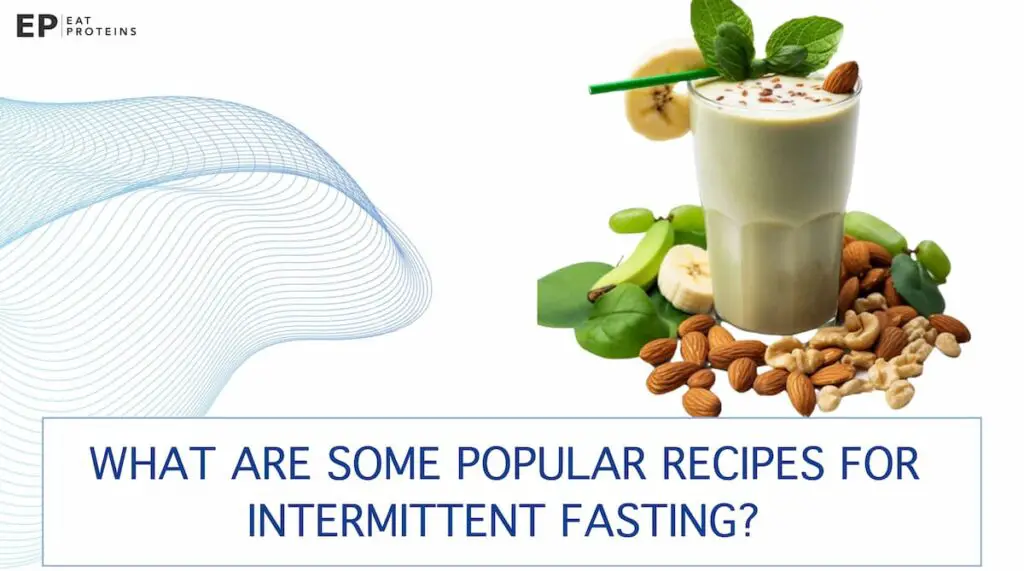
- Avocado Quesadillas
- Grilled Lemon Salmon
- Veggie-Packed Cheesy Chicken Salad
- Cobb Salad with Brown Derby Dressing
- Vegan Lentil Burgers
These recipes offer a variety of options for vegetarians and non-vegetarians, and they are suitable for different fasting windows.
How easy is it to cook your own meals while on intermittent fasting?
Cooking your own meals while on intermittent fasting can be easy with the 32 top recipes provided on EatProtines.com, offering a variety of delicious options suitable for different fasting windows and dietary preferences.
What are the top recommended books on intermittent fasting?
The top recommended books on intermittent fasting are listed below.
- “Fast. Feast. Repeat.: The Comprehensive Guide to Delay, Don’t Deny Intermittent Fasting–Including the 28-Day FAST Start” by Gin Stephens, published in 2020.
- “The Fast Diet” by Michael Mosley, published in 2013.
- “Intermittent Fasting Diet Guide and Cookbook: A Complete Guide to 16:8, OMAD, 5:2, Alternate-day, and More” by Becky Gillaspy, published in 2020.
What is the best free Intermittent Fasting app?
The best free intermittent fasting app based on sources across the web is “Zero,” which is widely recognized for its user-friendly interface and comprehensive tracking features. Here are five popular intermittent fasting apps you might consider:
- Fasting – Intermittent Fasting
- LIFE Fasting Timer & Tracker
- BodyFast
- FastHabit Intermittent Fasting
- Zero
What is the best meal delivery service for Intermittent Fasting?
The best meal delivery service for intermittent fasting based on features like meal quality and customization options is “Factor Meals,” which offers specialized meals designed to fit within fasting windows. Other options like Clean Eatz Kitchen, Everyplate, and Green Chef also offer meal choices that can be adapted for intermittent fasting.
What are the best restaurants for Intermittent Fasting?
The best restaurants for intermittent fasting are those that offer customizable, portion-controlled meals with high-quality proteins and vegetables, such as Chipotle or Dig Inn.
Can you have a cheat day on an Intermittent Fasting diet?
Yes, you can have a cheat day on an intermittent fasting diet, but it may impact your overall progress.
Can you have alcohol on an Intermittent Fasting diet?
Yes, you can have alcohol during your eating window in an intermittent fasting diet, but moderation is key as it can affect fat loss and overall health.
Is coffee allowed during the fasting window in intermittent fasting?
Yes, black coffee is generally allowed during the fasting window in intermittent fasting as it contains minimal calories.
What are the different types of Intermittent Fasting methods?
The following list shows 14 different types of Intermittent Fasting methods.
- 16:8 Intermittent Fasting
- 18:6 Intermittent Fasting
- 20:4 Intermittent Fasting
- The Warrior Diet
- 12:12 Intermittent Fasting
- 5:2 Diet
- Eat-Stop-Eat
- Random Meal Skipping
- Fasting Mimicking Diet (FMD)
- One Meal a Day (OMAD)
- Two Meals A Day (TMAD)
- Alternate-Day Fasting (ADF)
- 36-Hour Fast
- 48-Hour Fast
16:8 Intermittent Fasting
In the 16:8 intermittent fasting method, also known as leangains diet, you fast for 16 hours and limit your eating to an 8-hour window each day. This is one of the easiest fasting methods to follow, and it aligns well with a typical daily routine, making it sustainable. Some people find it hard to consume enough nutrients within the 8-hour eating window, and social or family gatherings may fall outside of the designated eating times.
18:6 Intermittent Fasting
In the 18:6 intermittent fasting method, you fast for 18 hours and eat within a 6-hour window each day. This method may offer greater weight loss and blood sugar control benefits due to the longer fasting period. However, the limited 6-hour eating window could make it difficult to meet nutritional needs and may interfere with social activities involving food.
20:4 Intermittent Fasting
In the 20:4 intermittent fasting method, you fast for 20 hours and eat during a 4-hour window. The long fasting period can yield significant metabolic benefits. However, the short 4-hour eating window may not provide sufficient time to meet nutritional needs.
The Warrior Diet
In the Warrior Diet, similarly to the 20:4 intermittent fasting method, you fast for 20 hours and eat a large meal during a 4-hour window, focusing on whole foods. The focus on whole foods can improve overall nutrition, and the extended fasting period may offer metabolic benefits. However, the limited eating window can make it difficult to meet all nutritional needs.
12:12 Intermittent Fasting
In the 12:12 intermittent fasting method, you fast for 12 hours and eat during the remaining 12 hours of the day. This is the least restrictive method, making it easy to adopt and maintain. However, the benefits may be less pronounced compared to other, more restrictive intermittent fasting methods.
5:2 Diet
In the 5:2 diet, you eat normally for five days of the week and reduce your calorie intake to around 500-600 calories on the remaining two days. This method offers flexibility and allows for more normal eating patterns on non-fasting days. However, the extreme calorie reduction on fasting days can lead to hunger, irritability, and reduced energy levels.
Eat-Stop-Eat
In the Eat-Stop-Eat method, you fast for a full 24 hours once or twice a week. This method offers significant calorie reduction, potentially leading to quicker weight loss. However, a full day without eating can be very challenging and may cause extreme hunger and fatigue.
Random Meal Skipping
In the Random Meal Skipping method, you skip meals spontaneously, without a set schedule. This offers the most flexibility and can easily be adapted to different lifestyles. However, the lack of a set schedule could make it hard to track caloric and nutrient intake.
Fasting Mimicking Diet (FMD)
In the Fasting Mimicking Diet, you consume very limited calories for five consecutive days per month to mimic the effects of fasting. This method aims to offer the benefits of fasting without completely abstaining from food. However, it may be difficult to adhere to due to the complexity and strictness of the diet plan.
One Meal a Day (OMAD)
In the One Meal a Day method, also known as the OMAD diet, you fast for 23 hours and eat one large meal in a 1-hour eating window. This method is simple to follow and can lead to significant calorie reduction. However, consuming all daily nutrients in one meal can be challenging, and this extreme approach isn’t suitable for everyone.
Two Meals A Day (TMAD)
In the Two Meals A Day method, also known as TMAD, you eat two meals a day with fasting intervals in between. This method offers a balance between fasting and eating, making it easier to meet nutritional needs. However, some people may find it challenging to only eat twice a day, leading to potential overeating during meal times.
Alternate-Day Fasting (ADF)
In Alternate-Day Fasting, you alternate between days of regular eating and days of fasting. This approach can yield significant weight loss and improvements in metabolic health. However, the frequent shift between eating and fasting can be hard to maintain and may cause mood swings.
36-Hour Fast
In the 36-hour fast method, you fast for a full 36 hours, typically once a week. The extended fasting period could lead to significant weight loss and metabolic benefits. However, going a day and a half without food can be extremely challenging and may result in severe hunger and fatigue.
48-Hour Fast
In the 48-hour fast method, you abstain from eating for two full days, usually done less frequently, like once a month. This method offers the potential for significant calorie reduction and weight loss. However, it’s a very extreme form of fasting that could lead to nutrient deficiencies and is not recommended for everyone.
What is the best intermittent fasting method for losing belly fat?
Time-restricted feeding (TRF) with a feeding window of 4–12 hours is the most practical intermittent fasting method for losing belly fat, as it is effective in reducing body weight and waist circumference. However, individual results may vary, and it’s advisable to consult a nutrition coach or dietician for personalized guidance.
How long does it take for the 16/8 intermittent fasting method to show results?
It is difficult to determine the exact time it takes for the 16/8 intermittent fasting method to show results. However, some studies have shown weight loss ranging from 0.8% to 13.0% of baseline weight after participating in intermittent fasting for a period of 2 to 26 weeks.
What results have people reported from intermittent fasting?
People have reported various results from intermittent fasting. While weight loss and improved sleep are common goals, some individuals have experienced significant improvements in their athletic performance, such as cycling. These improvements include faster times on personal bests and increased fitness levels, even without changes in training or equipment.
What are some success stories from intermittent fasting?
Some success stories from intermittent fasting include improved physical performance, faster personal best times, and increased energy levels. While individual results may vary, many people have reported positive effects on their weight management and overall health. It’s important to note that intermittent fasting should be approached with a balanced and healthy lifestyle.
Who are some famous people who follow intermittent fasting?
Five famous people who follow intermittent fasting are Hugh Jackman, Kourtney Kardashian, Jennifer Aniston, Jimmy Kimmel, and Halle Berry.
Is intermittent fasting considered healthy by medical professionals?
Yes, Intermittent fasting is considered a potentially healthy approach to weight loss by medical professionals, as it has shown promise in studies for promoting weight loss and improving glycemic control in patients with type 2 diabetes. However, more long-term research is needed to fully understand its sustainability and overall health effects.
What makes Intermittent Fasting different from other diets?
Intermittent fasting differs from other diets primarily in its focus on when to eat rather than what to eat. Traditional diets often involve calorie counting, food restrictions, or macronutrient balancing, whereas intermittent fasting cycles between periods of eating and fasting. This approach allows for more flexibility in food choices during eating windows and emphasizes metabolic health benefits like improved insulin sensitivity.
